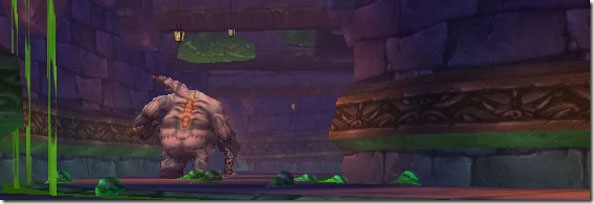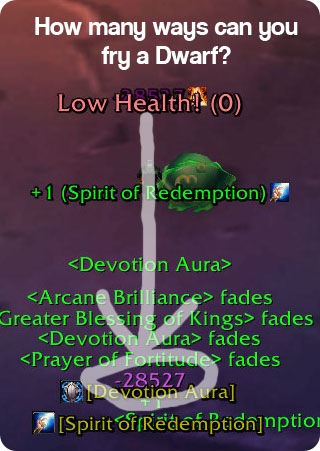
Image courtesy of Feralis.org
Lodur from Zul’jin here once again. This post I’d like to talk a little bit about healing Patchwerk as a restoration shaman. This will be a bit of a short post for me this week. Patchwerk for the longest time has been THE premiere check for your dps, your tanks and your healing. He is a perfect measuring stick for your raid if you think about it. He’s a straightforward fight, dps can sit and dps, tanks sit and soak damage and healers sit and heal. There’s no fancy gimmicks, no movement or fire to move out of , so it really is the perfect boss fight to check out your raids gear and ability.
You might ask youself “What is there to know? Don’t we just dump heals into tanks and call it a day? ” There are a couple different roles a shaman can play for healing through Patchy here. The two tried and true methods are Chain Heal spam and Lesser Healing Wave spam. Lets talk about the strengths of each for a moment here.
Lesser Healing Wave method.
- Quicker heals
- Using Glyph of Lesser Healing Wave allows the spell to hit for almost as much as Healing Wave
- Lower spell cost for more heals per mana spent.
- Quickly allows off tanks to be topped off to full health
Chain Heal Method.
- More efficient heals (5.3 healing per mana spent)
- Allows for both off tanks and main tank to be targeted and healed through the jumps of chain heal.
- Smoothes out healing on the off tanks so second healers have an easier time keeping the tanks health even.
- Allows for lag compensation due to added healing buffer.
Lesser Healing Wave Method:
This method is really straightforward. Simply put you keep Earth Shield up on your tank and continue to dump Lesser Healing Waves and Riptides into him constantly. Make sure to keep your Water Shield up for maximum mana regen and to make sure you have full charges available for Improved Water Shield. Using this method you have to apply healer tunnel vision. By that I mean you have to pay attention to your tank and only your tank, if you try to heal another OT or the Main Tank, your tank is likely to eat a large spike before you can top him off. This method allows for very little error but is very mana costly in the end.
Chain Heal Method:
Personally I prefer the Chain Heal method, let me explain a bit about why. Firstly, it is simply our most efficient heal. You get the most bang for your buck out of it and if you have your 4 piece set bonus from tier 7, or even if you’re still rocking a couple pieces of tier 6, you just get the most mileage out of it. Secondly it has a lot of synergy with some other talents that you will find useful for this fight.
Lets go ahead and assume you’re assigned to heal one of the two Hateful Strike tanks (I’m operating under the assumption you’ll be using the two OT strategy.) The tank you are specifically assigned to will be your the starting point of all your heals. He will get the most out of your chain heals. After that if the OT’s are situated right, it will bounce off of your tank and onto the second OT, thereby adding a buffer to that tanks healers. My experience has show that two restoration shamans placed on the OT’s produce enough of a healing buffer that the other healers have a light healing load, it makes sure to smooth out the spikes in healing you normally see. Think of it as like providing the driving baseline for a band, it helps set the framework for everything around it. There are a few more benefits to this. Lets say something goes terribly wrong and all of a sudden someone other then the OT’s takes a Hateful Strike, if you’re already chain healing you’ll be able to heal the person through the smart heal component without having to divert attention away from the OT’s in order to heal someone up. We can also assume you’ll be using a healthy smathering of Riptide it’s just going to pump your Chain Heal amount up that much more. Also, by using your chain heal you’re allowing for Tidal Waves to be up all the time so if you need to throw a LHW or a HW it hits for that much more.
All in all he’s not terrible for us, just make sure you have your Runic Mana potions and Mana Tide Totem ready to go to keep your mana up, and it should be smooth sailing for you. Both methods work (regardless of crit or haste gear =P ) and as long as you’re paying attention to your tank, you will easily succeed.
Now if you guys have a different way of doing it, please feel free to share =)
Till next time, Happy Healing!
~ Lodur



 When you kill him…
When you kill him…